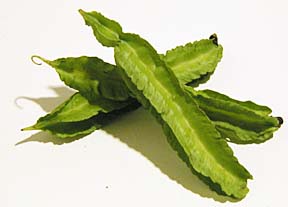

Key Ingredient

|
KEY INGREDIENT: WINGED BEANS
They look like large green caterpillars, kind of bug-like. In fact, they don't seem like foodstuff at all. They're called winged beans because of their frilly ruffled ridges and are a unique tropical legume favored in Filipino, Thai and East Indian cuisine.The basics: Winged or wing beans, also known as four-angle or asparagus beans, are believed to have originated in southern Europe and Africa, somehow making their way to tropical Asia.
The climbing vine is grown in part as a decorative garden plant and is not grown commercially on a large scale. The plant grows quickly and vigorously and is tolerant of high humidity. It is also a very versatile plant, as all parts -- shoots, seeds, flowers and tubers -- are consumed.
The precious pods are valued for their high protein content, which has been compared to soybeans. Their flavor is similar to green beans, but starchier. Because of their somewhat bland nature, they are well-suited to stir-fries or flavorful soups.
Selecting: Beans should be glossy and bright green. Beans that are about finger length will be tender; larger beans may be tough. Watch out for dried-out beans with blackened tips.
Storing: Use immediately or store in a plastic bag in the refrigerator for only a couple of days.
Use: Rinse beans and remove tips and any frilled edges that seem tough or fibrous. The beans can then be blanched and cooled for salads and side dishes. Stir-frying is probably the most popular use. Use curry, black bean and fish sauces, or other bold spices, to infuse flavor. Chop beans cross-wise and add to lentil or vegetable soups.
Where to buy: They are available all year, but are especially abundant in summer. Find them at Asian markets, farmer's markets and Chinatown at $1 to $2 for a small bag.
Food Stuffs: Morsels
Eleanor Nakama-Mitsunaga is
a free-lance food writer. Contact her
online through features@starbulletin.com